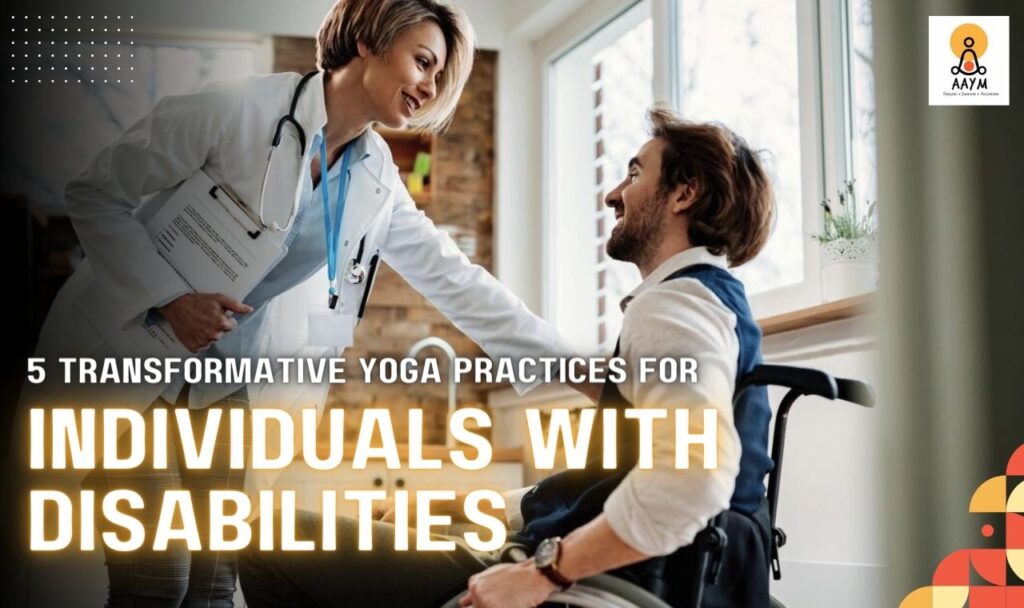Yoga, an ancient practice rooted in fostering harmony between the mind and body, can be a powerful tool for individuals with disabilities. It offers pathways to enhance physical mobility, mental clarity, and emotional well-being. The Adaptive and Accessible Yoga Movement (AAYM) champions this inclusive approach, ensuring yoga’s benefits are accessible to all. Here, we explore five transformative yoga practices specifically adapted for individuals with disabilities, illustrating the adaptability and inclusivity of yoga.
1. Chair Yoga
Chair yoga is an excellent practice for individuals who experience difficulty with standing or floor-based exercises. This practice adapts traditional yoga poses for a seated position, making yoga accessible for those with mobility challenges. Key asanas include:
Water’s buoyancy reduces joint stress, making water yoga ideal for those with physical disabilities or arthritis. Performing yoga in water can improve strength, flexibility, and range of motion without the fear of falling. Essential practices include:
Iyengar Yoga uses props, such as belts, blocks, and blankets, to perform asanas accurately and without strain. This approach is particularly beneficial for individuals with disabilities, as it allows for the customization of poses to meet individual needs, facilitating improved alignment and accessibility. Noteworthy poses include:
Pranayama, or breath control, is a crucial aspect of yoga that can significantly enhance mental clarity and emotional well-being without physical strain. Breathing exercises can empower individuals with disabilities, offering tools to manage anxiety and improve focus. Key techniques include:
1. Chair Yoga
Chair yoga is an excellent practice for individuals who experience difficulty with standing or floor-based exercises. This practice adapts traditional yoga poses for a seated position, making yoga accessible for those with mobility challenges. Key asanas include:
- Chair Cat-Cow Stretch: Enhances spinal flexibility and stimulates the digestive tract.
- Seated Forward Bend: Stretches the spine and helps relieve stress.
- Chair Pigeon: Opens up the hips and improves lower body mobility.
Water’s buoyancy reduces joint stress, making water yoga ideal for those with physical disabilities or arthritis. Performing yoga in water can improve strength, flexibility, and range of motion without the fear of falling. Essential practices include:
- Aqua Warrior: Improves balance and strengthens the legs.
- Floating Savasana: Promotes deep relaxation and stress relief in a supportive environment.
Iyengar Yoga uses props, such as belts, blocks, and blankets, to perform asanas accurately and without strain. This approach is particularly beneficial for individuals with disabilities, as it allows for the customization of poses to meet individual needs, facilitating improved alignment and accessibility. Noteworthy poses include:
- Supported Triangle Pose: Enhances overall stability and strengthens the legs.
- Prop-assisted Shoulder Stand: Stimulates the nervous system and promotes circulation, with props making the pose accessible.
Pranayama, or breath control, is a crucial aspect of yoga that can significantly enhance mental clarity and emotional well-being without physical strain. Breathing exercises can empower individuals with disabilities, offering tools to manage anxiety and improve focus. Key techniques include:
- Ujjayi Breath: Calms the mind and reduces anxiety.
- Anulom Vilom (Alternate Nostril Breathing): Balances the left and right hemispheres of the brain, enhancing emotional equilibrium.
- Guided Visualization: Encourages relaxation and stress relief through mental imagery.
- Mindfulness Meditation: Enhances awareness and acceptance of the present experience, promoting emotional well-being.

